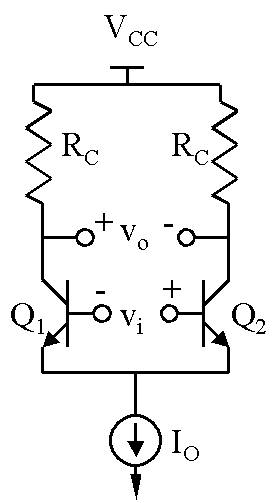
First, note that the points only add up to nine. This was an oversight. So everyone started off with one point just for turning in a paper.
1) (2 pts) Explain the basic mechanism by which a basic current mirror operates.
There are two key concepts to understand here.
First, there is a diode connected transistor. The base-emitter voltage of this transistor is automatically set to the value of vBE that corresponds to the collector current flowing in the transistor.
Second, this value of VBE is applied to another transistor which results in that same collector current flowing in that transistor.
2) (2 pts) Draw a basic BJT-based current mirror of both the NPN and the PNP variety.
Again, a lot of people are just replacing the NPN transistors with a PNP transistor. That simply does not work! If you can't look at such a circuit and see why it will not work, then you need to take a serious step back and review the basic, simplest large signal models for a transistor and make sure that you understand the differences between an NPN and a PNP transistor and how they work in a circuit. If you don't understand this then you are at a serious disadvantage when it comes to analyzing and/or designing any circuit using a transistor - let along performing small signal analysis/design of multi-transistor circuits. It is a shortcoming you need to overcome immediately because the analysis and design tasks are considerably more involved in Chapter 7.
3) (2pts) The emitter resistance of a BJT transistor is the ratio of the changes in what two parameters? Derive the equation which expresses the emitter resistance of a transistor in terms of its DC operating point values.
This question and its kissing cousins have been on the review sheets since Day 1. Some of them have already appeared on previous quizzes. All of them were worked in class in explicit detail during week #1. The definitions and derivations of the small signal parameters are fundamental to this course. You WILL see them on future quizzes and you will see at least one of these questions on EACH exam in this course.
Only five people gave the correct (or close to it) definition and only one person performed the derivation. If, at this point in the course and given as much emphasis as has been placed on this point, you still cannot answer this question then it is not surprising at all that you are having so much trouble with most of the other topics since these concepts are what all the rest are based on. It is VERY much like trying to analyze a DC circuit with nothing but voltage sources and resistors in it and not knowing what Ohm's Law is or what Kirchhoff's Laws are.
4) (3 pts) Derive the relationship between the fractional mismatch in collector resistance and the input offset voltage that results in the following BJT Differential Pair..

People has lots of problems here and in some cases it was in understanding what input offset voltage is. But in many cases the problems indicate very weak basic circuit analysis skills - including being able to determine what VO is even after determining what the current in each of the two collector resistors is. Again, without these fundamental skills, you will do nothing but struggle in this course.
Several people just plopped down the final answer. This gets you some credit - but remember that the problem asked you to DERIVE that relationship. Other people made a stab at it and made a variety of errors and yet somehow the answer magically ended being the right one. This is classic Magical Methods. DON'T DO IT!!!! Your answer MUST flow from YOUR work. It is fine to note a memorized result off to the side - preferably with a remark that it IS a memorized result - but don't (as in DO NOT) imply that it is the answer you got as a result of your work unless it IS the answer you got as a result of your work. From now on, full penalties are in effect for Magical Methods - namely that you will receive NO credit for the problem and may well receive a negative score.